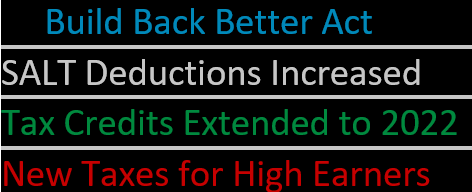Well, probably. There is a very good chance that the proposed tax law changes in the Build Back Better Act are going to impact your taxes, but that impact is going to vary based on your status as a low or high income taxpayer. I’ll hit on some of the highlights of the proposed changes before doing a very brief review of the logistics of the passing of a bill like this.
Whether this bill is going to increase or decrease your taxes, as an individual, really depends on how much you’re earning each year, whether you have any minor children, and how much income tax you typically pay to your state each year.
I’ll talk through each bullet in more detail below, but if you came here for the short version for individuals, here it is:
1. The limit on deductibility of state and local taxes you pay is going to increase
2. Larger tax credits for having minor children are extended
3. Earned income tax credit expansion for lower income families extended
4. Net Investment Income Tax (3.8% tax) extended to trade or business income (for people earning over $400k)
5. Additional 5% - 8% tax imposed on earnings over 10 million and over 5 million for married filing separately filers
There are a number of changes that impact businesses as well but they are a bit more specific and less likely to impact the taxes owed by the average taxpayer. I.e. increases to the tax applied to foreign corporate and foreign intangible income, a flat minimum tax on corporations earning over one billion annually, and an excise tax applied to corporations that repurchase corporate stock from shareholders.
Now if you’re looking for someone that is going to stare into a crystal ball and tell you the impact that these changes are going to have on the economy(jobs lost/created, increases to expatriation/immigration etc), you’ve come to the wrong place. My goal is to help you understand the tax changes that are going to directly impact you, and hopefully leave you in a better position to anticipate the impact these changes will have on your filings and adapt accordingly.
Deductibility of State and Local Taxes
2017 tax reform saw the imposition of a $10,000 limit on your ability to deduct state and local taxes (usually referred to as SALT). This $10,000 limit includes both the income taxes you pay to any state and the property taxes that you pay to any state. This change had a large impact on individuals that live in states that have an income tax who are earning a lot of money. To take New York as an example, if an individual was a single taxpayer who earned $1,000,000 a year while living and working in New York City in 2021, she would have paid $67,952 in taxes to the state of New York and $38,325 to New York City. Let’s also assume she owns a home in New York and pays $25,000 in property tax to New York each year as well. Pre-2017 reform, that taxpayer would have been able to deduct the $131,277 in taxes paid (based on when the taxes were paid). After the 2017 reform, they would only be able to deduct $10,000.
As you can see, this change had a significant impact on the tax filings of individuals earning a lot of money. I have personally seen many taxpayers who would previously file schedule A to claim itemized deductions who no longer have enough deductible expenses after this change to exceed the standard deduction.
The currently pending tax reform would increase the State and Local Tax deduction from $10,000 to $80,000. This provides high income taxpayers with an additional $70,000 of deductions which could result in a reduction of tax up to $25,900 (37% x $70,000).
With a standard deduction of $12,950 per taxpayer in 2022, it is likely that the average person will not receive a benefit from this change. Take for example a Massachusetts taxpayer that earns $200,000 in wages during 2022. The income tax rate in Massachusetts on earned income is 5%, so this individual would have (after application of the Massachusetts deductions) a MA income tax paid of $9,680. If this individual doesn’t have any other state and local taxes paid, based on their earnings they will not benefit from the expansion of the deduction for State and Local Taxes. Additionally, if they do not have any other itemized deductions (i.e. mortgage interest or charitable donations) they will be using the standard deduction, and will not be directly benefiting from or taking a deduction for their State and Local Taxes paid.
As you can see from the above examples, this change will have a significant impact for some taxpayers while failing to impact many others.
Child Tax Credit
This is a change that will impact a larger segment of non-high income taxpayers. Before 2021, the child tax credit was $2,000 per child and this credit was claimed on your tax return. This was a $2,000 credit ($1,400 of which could become a refundable credit) that would dollar for dollar reduce an individual’s tax liability. During 2021 the child tax credit was increased to $3,600 per child for children under the age of six and $3,000 for children that are age six or older. In addition to the adjustment to the amount of credit provided, there is now also a mechanism to have the credit paid out monthly to taxpayers during the year. One important thing to keep in mind regarding this change is that these payments being made throughout the course of the year will result in fewer credits on tax returns, which may mean individuals will find themselves owing more in taxes than they are accustomed to or at the very least receiving smaller refunds. Because people grow accustomed to receiving significant refunds each year, a change like this can be quite a shock for individuals that don’t realize the impact that the monthly payment of this credit has on their tax filings. If you have children and are receiving these payments, do not expect to receive as substantial a refund as you have in years past.
The Build Back Better Act extends these child tax credit changes to 2022, keeping the increased amount of credit available for each child and keeping the monthly payments of these credits.
Earned Income Tax Credit
This has historically been a refundable tax credit that is available to low income households. To qualify for the earned income tax credit individuals must meet income restrictions but must also have earned income (i.e. wages, business income, etc). For individuals with no children to take advantage of this credit for 2021, your adjusted gross income needed to be below $21,430 (or $27,380 if you file married filing jointly). These amounts scale up based on the number of children you have to a maximum of three children, $51,464 (or $57,414 if married filing jointly). These thresholds change each year.
The most significant change to the earned income tax credit for 2021 was the increase to the amount of the credit for which individuals with no children are eligible. This amount went from $538 in 2020 to $1,502 in 2021. The Build Back Better Act is poised to extend this 2021 increase through 2022.
Net Investment Income Tax (3.8% tax) extended to trade or business income (for people earning over $400k)
The Net Investment Income Tax (“NIIT”) is a 3.8% tax that applies to investment income of married filing separately individuals with a modified adjusted gross income above 125,000, Single/Head of Household individuals with a modified adjusted gross income above $200,000, and Married Filing Jointly//Qualified Widower individuals with a modified adjusted gross income over $250,000. This tax went into effect for tax year 2013 and since that time has applied only to investment income (i.e. interest, dividends, capital gains, rent/royalty income, business income without material participation, etc). Investment income did not include income from taxpayers’ businesses in which they materially participated. The proposal in the Build Back Better Act would subject all trade or business income to the NIIT for individuals earning more than $250k (MFS), $400k (Single), $500k (MFJ/Qualifying Widowers).
For individuals running their own successful pass-through businesses (LLCs, Partnerships, Sole-Proprietorships, S-Corps) this is a very significant change. This will serve as a flat 3.8% tax increase to the amount of income generated through their successful businesses. The profit from their K-1 or from their Schedule C will now be included as ‘investment’ income for purposes of Form 8960 (the NIIT form). That means this income would be subject to income tax at the taxpayer’s marginal rate, then subject to the self-employment tax, and then also subject to the NIIT.
Additional 5% - 8% tax imposed on earnings over 10 million and over 5 million for married filing separately filers
The Build Back Better Act also proposes a 5% tax on income over $10,000,000 ($5,000,000 for MFS filers, and $200,000 for an estate or trust) and a total of an additional 8% on income over $25,000,000 ($12,500,000 for MFS filers and $500,000 for estates and trusts).
To provide a quick example of the impact of this 5-8% in conjunction with the NIIT changes, if an individual is living and working in California and earns $26,000,000 through their pass-through business operations, the last million earned will have an effective rate of 37% of federal income tax, 12.3% of California income tax, 8% of additional federal income tax, and 3.8% of NIIT, and 2.9% for the Medicare portion of the self-employment tax, for a total of 64%.
We’re talking about a lot of income here, so it is awfully difficult for the average taxpayer to be sympathetic, but I think that everyone can agree that 64% is a significant percentage. This means that these individuals are effectively working until the middle of August just to pay their taxes, before any of their income is going to be staying in their pockets.
The Capitol Building where the Senate will vote on the Build Back Better Act
Build Back Better Act Bill Passing Logistics
Now I’d like to take a moment to discuss the logistics of passing a bill. To oversimplify a bit, for any proposal of this nature to become law, it must be approved by the House of Representatives, then approved by the Senate, before finally being signed into law by the president. In this case, the bill will need to pass the House and the Senate with a majority of the votes in each. This act passed the House of Representatives with a 220-213 majority and is moving to the senate. Keep in mind that the vice president is the deciding vote in the event of a tie in the senate. Also note that the senate is currently split 50-50 between democrats and republicans. Republicans are likely to wholesale oppose passage of this bill, which means that it will require the support of every Senate democrat and of the Vice President to pass the Senate.
These logistics can and often do have a significant impact on the substance of a bill. A strong example of that impact is the inclusion of the SALT limitation adjustments detailed above, as this is an issue that is important to some of the Democrats, with a Senate that has exactly 50 democrats, its inclusion has become necessary to the passage of this bill.



